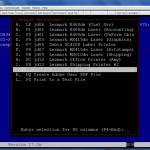Prior to issuing the shutdown command, you must determine if all users have exited back to the SCO login prompt. Just because a workstation has been turned off, it doesn’t necessarily mean that they have logged off properly. To start the system shutdown, enter the following commands:
Login: root
Password: xxxxxx (ask system supervisor)
# who
The system should only display one user being logged in and that should be root. You can re-enter the who command until you see that everyone has logged off properly. When you are ready to continue, issue this command:
# shutdown -g0
Shutdown automatically executes the sync and haltsys command and can allow 0 to 15 minutes before the shutdown takes place, allowing users to complete the work they are doing prior to issuing the shutdown command. The example above (-g0) is for 0 minutes.
The shutdown is complete when you see this prompt:
** Safe To Power Off **
or
** Press Any Key to Re-Boot **
Press the Enter key to reboot. When the server comes back up, a message like below displays:
Boot:
Press the Enter key to continue. If the Enter key isn’t pushed after a short period of time, the boot process will automatically continue.
Type CTRL+D keys to proceed with normal startup (or give root password for system maintenance).
Press the Enter key at the system date and time display.
The system will automatically return each workstation to their SCO login prompt.
ALT+CTRL+F1 keys will return the screen to the normal SCO Unix scosysv character login prompt on the server. ALT+CTRL+F3 can be used as a secondary login.
Note:
If the system is shutdown incorrectly or loses power while users have data files open, there is a probability of damage being done to records within any given file, causing corrupt file integrity. You must either run a restore procedure from a backup processed before the shutdown or run file rebuild programs to try and correct the errors.

